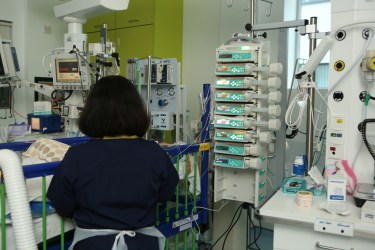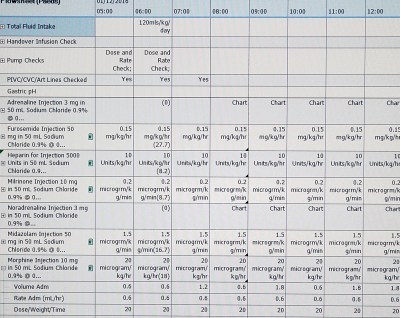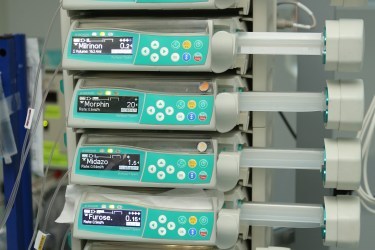National Smart-Pump Drug Library of Paediatric and Neonatal Standardised Concentration Infusions

Written By: Moninne Howlett, Chief II Pharmacist (Informatics), OLCHC
Introduction:
Critically ill, paediatric patients are a vulnerable cohort of patients at high risk of medication error. The particular risks associated with paediatric and neonatal infusions have been addressed by both safety agencies and governmental bodies over the last 15 years. Recommendations include the replacement of traditional individualised weight-based infusions with standard concentration infusions, and the use of smart-pump technology. Smart-pumps are computerised infusion devices with multiple safety features that include customised drug libraries, dose calculations based on programmed patient weights and the setting of dose limits. They have been shown to be highly effective in reducing serious and occasionally fatal medication errors. Further benefits of smart-pump technology include the integration that is possible between them and other health information technology solutions such as electronic health records and barcoded medication administration systems. Implementation rates in Europe fall far below those in the US, and up until 2012 implementation of these recommendations had not yet occurred in any paediatric and neonatal intensive care unit in Ireland.
The Challenge:
No guidelines or standards on how to implement the recommendations regarding the use of standardised infusions and smart-pump technology exist. The development of a drug library of agreed standardised concentration, and engagement of hospital pharmacists have been identified as limiting factors.
Patients in the paediatric intensive care setting are a diverse group of patients, ranging from premature infants to teenagers. Any system devised had to be able to accommodate the entire spectrum of patient weights, from under 1kg to over 100kg.
Resistance to change had to be overcome and the case for moving from the well-established traditional system for the prescribing, preparation and administration of infusions had to be made.
Prior to commencement of this project, the absence of a locally held drug library content management system, meant that all library parameters had be communicated to the infusion pump vendor to allow the drug library to be built. To minimise costs, the library had to be fully tested and validated, to enable a single mass upload to all pumps.
The Solution:
A multi-phase project, commencing in 2011 was undertaken by the Pharmacy and Paediatric Intensive Care Departments of Our Lady’s Children’s Hospital Crumlin (OLCHC) to implement the recommendations. The first phase of the project was to develop an agreed list of standardised infusion concentrations.
Modelling work was undertaken to identify the most appropriate concentrations over a number of different weight bands. Critical factors included balancing excessive infusion volumes with titratability of drugs at lower dose ranges, meanwhile minimising the number of concentrations to mitigate against selection errors. Using Microsoft Excel®, we developed individual calculators for a number of infusions. These facilitated calculation of proposed infusion volumes across the full range of patient weights within weight bands. This enabled us to efficiently predict the suitability of proposed standard concentrations for a broad range of patients.
To obtain the necessary ‘buy-in’ and achieve consensus from a heterogeneous group of clinicians and nursing staff, a number of staff information sessions were held. The merits of the new system were presented as out-weighing the challenges of adopting new practices. Supporting documentation and guidelines were devised and approved and training sessions were run over a number of weeks for approximately 175 OLCHC staff. Implementation of the new system to the paediatric intensive care unit (PICU), theatres and the children’s cardiac ward occurred over 2 days in May 2012.
Shortly after implementation, a new clinical management content system (CIMS) was introduced into the PICU in Crumlin. We created of a range of ‘standard orders’ or prefilled electronic prescriptions for each standard concentration in each weight band. Only those orders appropriate for each patient are made available to the prescriber. Secondly we set up a uni-directional interface between the pumps and the CIMS facilitating automatic transfer of real-time data from the pumps to the CIMS, a system not yet available in the majority of paediatric institutions across Europe.
Expansion Beyond OLCHC:
In 2014, the new Irish Paediatric Acute Transport Service was commissioned and was to be run out of the PICUs in both OLCHC and Temple Street Children’s University Hospital. Due to the differing practices across sites, a decision was made to extend the project to those sites also.
A cross-site collaborative multi-disciplinary working group was formed and the OLCHC drug library was further developed to enable its use across all sites. This involved substantial negotiations to achieve consensus and ensure standardisation of practices. In the absence of an existing over-arching governance structure and to ensure the integrity of the library was maintained, legally binding agreements were drawn up between OLCHC, the infusion pump vendors and recipient sites, to prevent future deviations from the agreed library.
By early January 2015, this system for the delivery of infusions was implemented successfully across both PICUs and the paediatric transport service.
Expansion to the Neonatal Setting:
A further initiative was undertaken by OLCHC to extend this project to the broader neonatal population. In 2014, a subsidiary neonatal-specific smart-pump drug library was also developed. This initiative was endorsed by the Neonatal Advisory Group of the National Clinical Programme for Paediatrics and Neonatology, including the National Neonatal Transport Programme, and the National Maternity and Neonatal Clinical Management System project team. The neonatal intensive care unit in the Coombe Women & Infants University Hospital was the pilot site and implementation occurred there in July 2016. Implementation in Cork University Maternity Hospital occurred in early November, with a phased roll out to the other 17 neonatal units planned.
The Benefits:
- The risk posed to critically ill children from potential adverse outcomes due to medication error has been significantly reduced.
- All tertiary paediatric sites in Ireland are aligned with best practice recommendations for the delivery of infusions of high-risk medications.
- Safety of patients during the high-risk process of transport and retrieval from regional hospitals to PICU, and between PICUs has been improved.
- Expansion of this system to the neonatal setting has commenced and is progressing well.
- Significant progress has been reached in advancing standardised care for critically ill children and infants in Ireland.
- Standardising practices across sites is laying important preparatory work prior to the opening of the New Children’s Hospital.
- Effective use of existing resources have been maximised by the sharing of expertise and experience, and successful collaboration.
- The content management system for further development of the drug libraries isnow in use in OLCHC. Work is on-going to develop future drug libraries for use in specific care settings and to expand the use of smart-pump technology outside of the critical care setting
Next Steps:
Preliminary plans are underway to extend this system to paediatric patients cared for in adult ICUs, regional hospitals or during stabilisation prior to transport to a paediatric tertiary hospital.
Negotiations are underway with the HSE to develop a national managed service, support and governance for this project.
Options to replace the current process of uploading infusion pumps with the drug libraries to a central, automated upload process are being explored.
A long-term objective is that current practices in Ireland for preparing high-risk infusions, overwhelmingly performed by nurses at the bedside, will be replaced by the use of pre-prepared infusions. This would have substantial economic and safety benefits, while also accommodating routine use of barcoded medication administration. Extensive standardisation across different healthcare settings will be a primary driver for these further advancements.
Conclusion:
The effective use of smart-pump technology can be applied in the neonatal and paediatric setting to improve the safe delivery of high-risk medications. Effective collaboration can enable wide-scale standardisation of practices and efficient use of resources. The standardisation achieved by this project has made significant progress towards achieving long term goals of centralised processes for drug-library development, dissemination and preparation of infusion solutions.
Acknowledgements:
This project was only possible due to the commitment and expertise of a huge number of individuals across both the paediatric and neonatal setting. I would also like to acknowledge the considerable support and assistance provided by B.Braun Medical Ltd.
- Ambulance Arrivals Project A Case Study
- SNOMED National Release Centre (NRC)
- SVUH Award winning Patient Flow Whiteboard
- Scan for Surgery
- Hospital-based care
- Digital Natives Sign App
- Digitisation of risk assesment tools for Adult mental health services in north Dublin
- Patient Engagement Operating Systems - Hep C
- Digital Transition for HSCPs at St. James's Hospital
- Primary Care Centre Castlebar Case Study
- Mario - Managing active and healthy ageing using caring service robots
- Claimsure - Health Insurance Claims Management System
- Cyber Attack Response
- Data systems in SVUH Emergency Department
- Electronic Discharge Prescription Pilot
- Epilepsy EPR
- eReferral
- eReferral Radiology Pilot
- eRostering
- Electronic Blood Tracking
- GP Practice Management Systems
- Healthmail
- Heart Failure Virtual Clinic
- Infrastructure - MPUP to ECAM
- IT Security - Small changes, big difference
- Kidney Disease Clinical Patient Management System
- Local Asset Mapping Project at St James' Hospital
- LUCY
- Mi Kidney App
- Model Community
- NCHD - Employment Record Portal
- Nursing & Midwifery Quality Care Metrics
- Ophthalmology Electronic Patient Record
- PharmaBuddy
- Radiology & Electronic Patient Record
- National Smart-Pump Drug Library of Paediatric and Neonatal Standardised Concentration Infusions
- Quality & Patient Safety
- Robotic Assisted Surgery Programme
- Shared Learning on EHR
- St. James' Hospital - National Haemophilia System
- Tallaght Hospital Pharmacy
- Tallaght Hospital Patient Engagement App
- Track & Trace
- Using IT to Improve Ireland's Public Sector Healthcare
- National Audiology Clinical Management System (NA-CMS)
- St Vincent's University Hospital Award Winning Whiteboard Patient Flow System
- Snomed Case Study
- Telehealth Project Donegal
- St Vincent's Whiteboard Patient Journey System a Case Study
- Ambulance Arrivals Project



